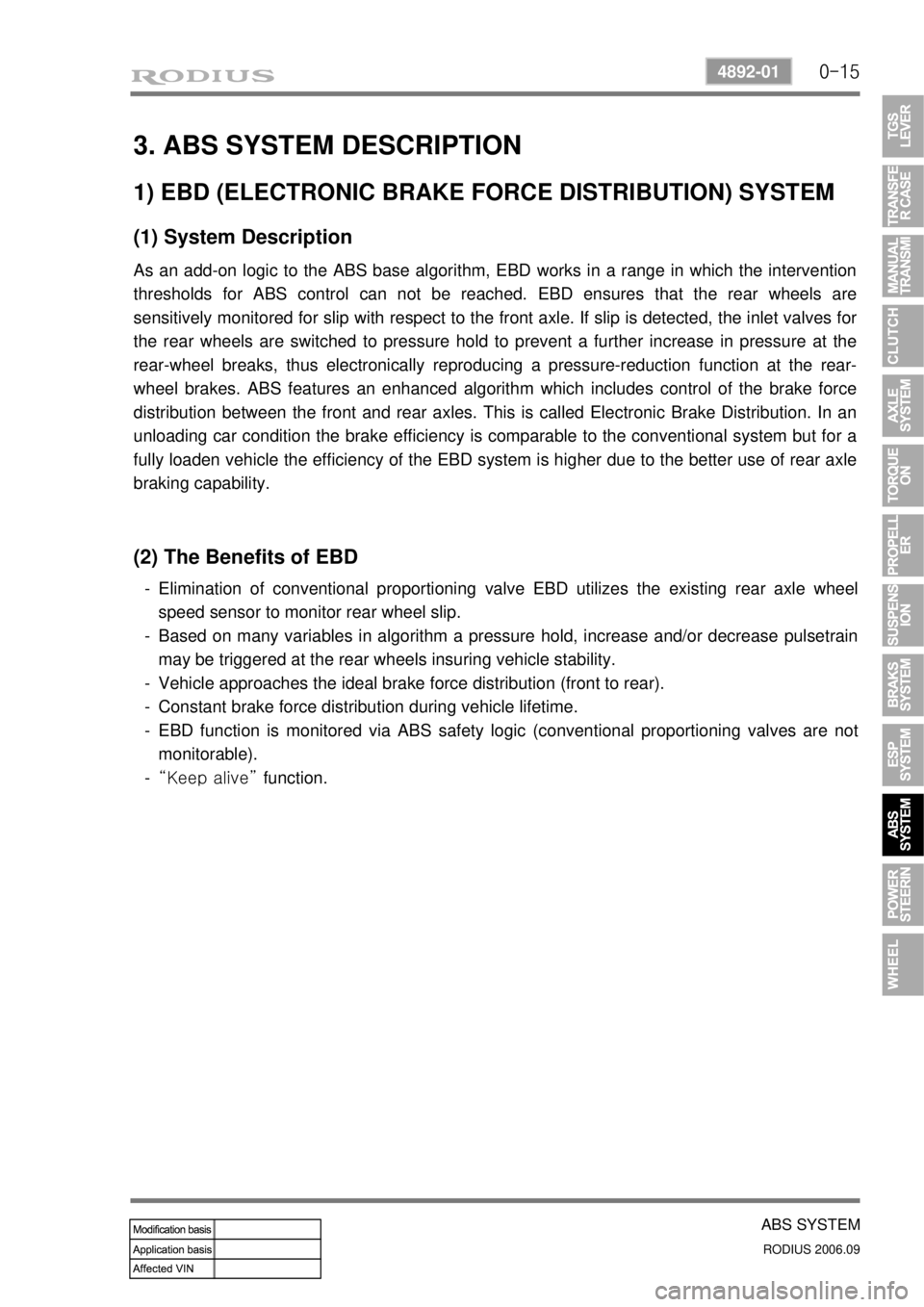Page 335 of 465
0-15
ESP SYSTEM
RODIUS 2006.09
4892-01
<0d96006c007a00770047006f00a0008b00990088009c00930090008a0047009c00950090009b00470090009500470090008b009300900095008e004700880095008b00470095009600990094008800930047008900990088009200900095008e0047009700
96009a0090009b009000960095>
In this position, the separation valve and the inlet valve are open (normal open), the electrically
operated shuttle valve and the outlet valve are closed. When the brake is applied under these
conditions, the brake fluid will be sent to each wheel via the separation valve and inlet valve.
Page 336 of 465
0-16
RODIUS 2006.09
4892-01
ESP SYSTEM
▶When applied ABS (decreased pressure)
The pressure decreases just before the wheel speed drops and the wheels. The inlet valve
closes and the outlet valve opens as in the ABS HECU and the oil is gathered at the low
pressure chamber while no additional oil is being supplied.
Then the pump operates to allow fast oil drainage.
Page 337 of 465
0-17
ESP SYSTEM
RODIUS 2006.09
4892-01
▶When applied ABS (maintained pressure)
The Inlet valve and outlet valve will be closed to maintain the pressure in the hydraulic circuit
applied at the wheels. By closing the valves, the hydraulic pressure at the wheels will not be
lost or supplied any more. During ESP operation, the separation valve closes and only the
shuttle valve at the pump opens.
Page 338 of 465
0-18
RODIUS 2006.09
4892-01
ESP SYSTEM
▶When applied ABS (increased pressure)
The shuttle valve and inlet valve will be open and the separation valve and outlet valve will be
closed. Then, the pump is operated.
When ESP operates while the ABS is operating, the pressure will be increased continuously
until just before the corresponding wheel gets locked.
Page 339 of 465
0-19
ESP SYSTEM
RODIUS 2006.09
4892-01
▶Hydraulic Diagram of HBA
The above figure shows one front and one rear wheel and the same hydraulic circuit forms as
in the ESP operation.
When HECU recognizes that it is an emergency and it is required for hard braking, depending
on the pressure value of the brake pressure sensor and pressure changes caused by the
pressure sensor timing, it operates the pump immediately to apply the brake pressure at the
wheels.
Then, the pressure in the pump increases until just before the corresponding wheel gets locked.
The motor still keeps rotating and the outlet valve and the separation valve are will stay closed.
When the wheel starts to lock, the HBA function cancels and switches to ABS operation.
Page 340 of 465
0-20
RODIUS 2006.09
4892-01
ESP SYSTEM
4. ELECTRICAL CIRCUIT DIAGRAM
<0d96007e008f008c008c00930047007a0097008c008c008b0047007a008c0095009a0096009900530047007a009b009600970047007300880094009700530047006b00900088008e00950096009a0090009a00530047007e008800990095009c0095008e00
4700730088009400970047004f00680069007a0056006c007a>P)
Page 341 of 465
0-21
ESP SYSTEM
RODIUS 2006.09
4892-01
<0d960069009900880092008c004700770099008c009a009a009c0099008c0047007a008c0095009a0096009900530047006c007a00770047007a008c0095009a0096009900530047007a008c0095009a009600990047006a0093009c009a009b008c009900
530047006c007a007700470076006d006d0047007a009e0090>tch
Page 354 of 465

0-15
ABS SYSTEM
RODIUS 2006.09
4892-01
3. ABS SYSTEM DESCRIPTION
1) EBD (ELECTRONIC BRAKE FORCE DISTRIBUTION) SYSTEM
(1) System Description
As an add-on logic to the ABS base algorithm, EBD works in a range in which the intervention
thresholds for ABS control can not be reached. EBD ensures that the rear wheels are
sensitively monitored for slip with respect to the front axle. If slip is detected, the inlet valves fo
r
the rear wheels are switched to pressure hold to prevent a further increase in pressure at the
rear-wheel breaks, thus electronically reproducing a pressure-reduction function at the rear-
wheel brakes. ABS features an enhanced algorithm which includes control of the brake force
distribution between the front and rear axles. This is called Electronic Brake Distribution. In an
unloading car condition the brake efficiency is comparable to the conventional system but for a
fully loaden vehicle the efficiency of the EBD system is higher due to the better use of rear axle
braking capability.
(2) The Benefits of EBD
Elimination of conventional proportioning valve EBD utilizes the existing rear axle wheel
speed sensor to monitor rear wheel slip.
Based on many variables in algorithm a pressure hold, increase and/or decrease pulsetrain
may be triggered at the rear wheels insuring vehicle stability.
Vehicle approaches the ideal brake force distribution (front to rear).
Constant brake force distribution during vehicle lifetime.
EBD function is monitored via ABS safety logic (conventional proportioning valves are not
monitorable).
“Keep alive” function. -
-
-
-
-
-